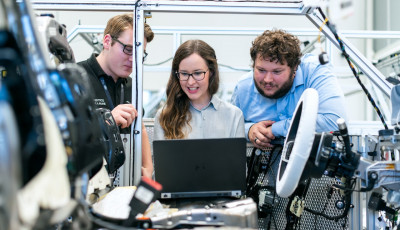Innovation means a new beneficial change that has been implemented. However, change usually generates resistance, especially when the benefits are neither clear nor substantial. Instead of enthusiastic involvement, we might face something very different: “I don’t want to get used to something new again! Let me do things the way I’m used to.”
Let’s start with a story.
Helmes helped a major hospital in Estonia use their new body scanners – multi-million euro devices for examining patients – more efficiently. It was clear that the expensive equipment was not being used to its utmost capacity; it was difficult to book a time for a scan, and waiting times for patients were long. The parties at the hospital did not understand how they could help improve the situation and did not believe that technology could make a difference.
Once Helmes had collected the necessary data on the processes, we created a smart solution that calculated the time taken for procedures, found opportunities, and thus significantly improved the efficiency of using the devices. An appointment now takes a few seconds to find instead of several minutes, and 60% more patients can get a scan in the same amount of time!
A smart solution can only happen with the cooperation of people who can find the time, help collect the data, and are willing to test new ideas. If you are going to innovate, it’s important to find these people in the organization, actively involve them and point them out to others as role models.
Who could request innovation?
Companies must innovate digitally to make people work better, smarter, and more efficiently. There is room for improvement in virtually every area. As we can see, even the work of doctors can be made more nimble by technology. On the one hand, the challenge is to find the most crucial problem areas, but on the other hand, there is always the question of how people will embrace innovation. In addition, people often don’t know how to request innovation – this mindset goes back to when Henry Ford was told: “Why are you offering me a car? Offer me a faster horse!”
There’s an innovation curve that defines the typologies of innovation and its implementers.
- The most innovative are the enthusiasts, but there tend to be only a few; the number of visionaries, who believe in the effectiveness of innovation and have made it clear to themselves, is slightly higher.
- The largest number of people are either pragmatists who follow the previous types and will give it a go if they see success or conservatives who only start using the innovation when everyone else is already doing it.
- Finally, there are the skeptics who are forced to go along because their old options aren’t available anymore (like the horse vs. the car).
Different typologies may manifest themselves in the same person in the case of different projects. However, it’s still worth asking yourself – do I facilitate innovation, ignore it, or work against it?
Don’t forget people when developing technology
Innovation means a new beneficial change that has been implemented. The key word here is ‘implemented’ because if no one adopts a new and potentially helpful invention, it may be an experiment, but it’s certainly not an innovation. So, no matter how modern and innovative a technology is, the person who creates innovation with a new product or approach is at the heart of it all.
But how do you convince people in a work team to use a new solution? This is a crucial issue, because organizations often forget that they must develop people’s skills and mindsets when developing technology.
And once again, the manager is the first person everyone looks to when the question arises: how have people in one organization successfully gone through a painless transition, while in another, change led to defiance and teams falling apart? How can some people be managed so that their inner antagonist is reigned in, but another group seems to be led by all-powerful resistance – a mixture of mistrust and fear?
Most of the time, people’s behavior is influenced by ignorance and perhaps by trivialities that have built up before. Managers have to decide whether they are willing to take a little more time to actively involve people and listen to them, provide answers and listen again, or make decisions without much involvement and explanation.
However, managers deal with a more complex process. If resistance has emerged, the time necessary to quell and manage it is usually longer than the time needed to prevent it.
Resistance isn’t always bad
Everyone probably has their own stories of resistance to change to share. They emerge on their own, unnoticed and often initially silent. They can emerge in daily meetings where all parties are not heard (“Why wasn’t I asked for my opinion?”), it can arise from people being relocated in the office without further explanation (“Why do I have to move to another place but he can stay?”), it can be caused by salary negotiations where a person has set higher personal expectations than permitted by reality (“I’ve heard that’s what the others get”), or it can come from being terminated where the person is not given the reason for the decision or knows what comes next – fear, fear, fear.
There are also many people who believe that resistance has its merits. It helps to get to the heart of the problem and bring out everything hiding under the surface. In this case, time must also be set aside for all parties to discuss the issues properly and pack them up safely. Today, no organization can afford a situation where people leave, slamming the door shut behind them, full of the same resistance, and remain negative brand ambassadors in the labor market.
So, there are processes for implementing innovation that a good leader must take into account – the most important of which are creating a safe and inspiring environment and supporting people in their strengths by providing the right approach to embrace change. It’s important to prevent resistance, because introducing change in that atmosphere breaks down the climate inside a team, slows down the change taking effect, and creates negative attitudes towards it.
Get in touch




